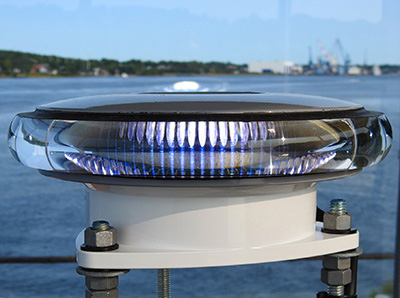Wow look at those cooling fins, what a monster!
Thanks for posting the pic, and also the link!
This is what Graphics cards will look like in 10 years
Kids at school already have it as the new haircut
They look thick and inefficient
The whole thing is only 32cm tall, so the fins aren’t as thick as they look.
The bulb (with aluminium heatsink) is 11×40×23 cm overall and 200W (1165cd/cm²), with monitoring and sync options.
Bcs it’s a neat design:

But perhaps to note - bulbs like that are only if you want to keep those giant rotating fresnel lenses (and even with that those LEDs on that bulb still need a lens on their own).
The simpler solution is to use one of the new designs, without the old lenses or even without the whole old lighthouse structure, eg:


That’s really cool, thank you.
I like how it goes from being a light turbine to a water-cooler.Lighthouse are cool, i’d be really sad to see the structure go.
The specs say it replaces a traditional 500w-1500w light source with a 200w LED fixture. I’m honestly surprised at how low that is overall. I would expect that a lighthouse would be using at least 10kw of power or more, especially in areas prone to fog. I can only assume that there are lenses to focus it down to a tight beam.
For comparison, I recently installed LED lights in a moderately-sized industrial area. Total power consumption is a little over 2kw, or 10 lighthouses.
That’s the difference between making a light that can be seen over a large area vs lights to brightly illuminate a large area. Lighthouses only need to be seen not illuminate the sea.
But yeah, I would have guessed it to be higher as well.
I had a 100W LED that would put your eye out. Even with a fat heat sink and fan it partially burned itself. Kinda scary to deal with.
I’m guessing each LED is 200W?
200W total. The thing is only 32cm tall and recommend to be run at a 50% max duty cycle.
Those fins are dissipating way more than 200W
It looks like it’s passive cooling? I don’t see a fan, which means you’ll need way more fins.
Even for incandescent technology, the efficiency actually goes up with wattage, whilst for LEDs it’s roughly the same (if I remember correctly, it mostly decays with temperature), so even for incandescent the gains in switching to LEDs actually fall as the original lamp wattage goes up.
Further, given the consumption of lighhouse lamps it makes sense that they had already been switched earlier from incandescent or similar, to the same kind of tech as street lights (i.e. some kind of high power fluorescent), which is a more efficient tech.
Last but not least there is one fluorescent technology (I’m not sure anymore if it’s sodium vapor or if it is mercury vapor) that is (or at least it was a few years ago) more efficient than LED technology, but only really works well for very large lights (again, I roughly remember something like 1000W - so stuff like stadium illumination). At least in terms of consumption there is no point in changing from that to LED technology as it would be a step back.
So it makes sense that for some lighthouse lights they’re not even replacing the lights with LEDs whilst when they do replace them the gains percentage-wise are a lot less than one would get from replacing one’s 80W incandescent light bulbs with the equivalent modern LEDs (which would be maybe 12 - 15W).
Hey, lighthouse expert here with a tip for your next visit: Despite common belief you should NOT look directly into the light from 5 feet away.
the trick’s on you - it’s not open for tours at night.
Looks super repairable too, just desolder, unscrew and then replace and resolder. Nice that the whole thing doesn’t have to be tossed.
Those are heat radiators (above and below)? Is this thing liquid cooled?
EDIT (just saw the link): So yeah those are heat sinks, but I’m not seeing if they are liquid cooled. Maybe not.
Yes. LEDs on that scale generate a lot of heat. Far less than a normal bulb on the same scale, but the problem is that an LED array is more compact and sensitive, so it retains heat much better, and is more sensitive to it.
Source: I’ve retrofitted a lot of old ships with more modern LED “bulbs” for their search light.
Kinda crazy to think about considering that LEDs are so efficient that they typically do not produce any significant heat at the use cases we’re used to.
The part that emmits the light doesn’t produce heat radiation like a incondecent bulb, but the circuits driving them do.
That’s not exactly true. The LED itself also emits heat. In most cases, this is more than the driver.
/Flashlights enters the chat.
LED bulbs for vehicles also usually have at least a heat sink. Some of them even have a fan or other active cooling.
I’ve only seen it in enthusiast level flashlights lol.
I have a few that will hurt your hand after a bit, and most have a heat cutoff sensor.
The link should have all the details!
Looking at the datasheet and pictures I think the heatsink is just aluminum. Looks like an extrusion (which means it’s the same shape over the full length) with a solid center that they machine down in the middle area to mount the LEDs. The large amount of material and good conduction of the aluminum will absorb and distribute the heat without needing water cooling or heat pipes.
These LEDs use up to 200W and the heatsink on here probably weighs more than 10x as much as a heatsink on a 500+W graphics card. Watercooling and heat pipes are necessary when you need to get a lot of heat out with a minimum amount of material, such as for cars and home computers. Costs more than a big block of aluminum but the you don’t need to move that much wieght around. For a light like this, the extra weight and space it takes up doesn’t matter.
Additionally, less moving parts should mean less failure cases that need to be addressed. As a light house lamp, less failures seems like a good thing!
Probably not, I think. The only mention of cooling I saw on the website was “Anodised heat sinks to maintain cool running of LEDs on steady burning duties.”
I’m so dumb, wondered how it rotated if the lights go all around. Duh, it simply blinks at appropriate intervals.
Nope, those huge lenses spin around it
Um, what?
EDIT
Their website says it’s suitable for fixed placement or rotation.
https://www.sealite.com/lighthouse-led-lights/
EDIT 2
Oh maybe this is what you meant, quote from the website:
Directional setup of LEDs for additional power saving by not shining light over land where not required
Thanks for sharing!
deleted by creator





